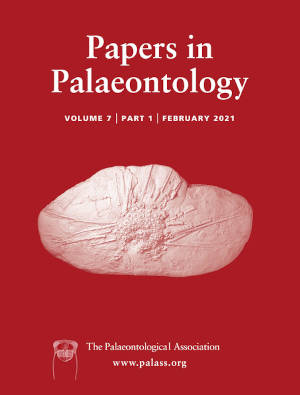Reg. Charity No. 1168330

The Aras Valley section (north-west Iran) exposes a sedimentary succession that allows the study of ostracod diversity patterns during/across the end-Permian mass extinction. For the present study, 59 samples were investigated for their ostracod abundances, which ranged from 4 to 31 500 specimens per 500 g. In 45 sample horizons, the ostracods were identified to the species level. In total, 3 425 specimens were determined and 62 species were identified, of which one genus and ten species are described for the first time: Fabalicypris veronicae Gliwa, sp. nov., Orthobairdia capuliformis Gliwa, sp. nov., Araxobairdia formosa Gliwa, gen. et sp. nov., Bairdiacypris kathleenae Gliwa, sp. nov., Eumiraculum mettei Gliwa, sp. nov., Liuzhinia julfensis Gliwa, sp. nov., Carinaknightina hofmanni Gliwa, sp. nov., Cavellina fosteri Gliwa, sp. nov., Cavellina hairapetiani Gliwa, sp. nov. and Hungaroleberis striatus Forel, sp. nov. The assemblages show, at the end-Permian mass extinction event, a complete turnover from a low-diversity Fabalicypris-dominated pre-extinction community to a more diverse Bairdiacypris-dominated post-extinction community. The turnover coincides with the significant temperature increase that was previously recorded from north-west Iranian sections. The low diversity in the horizon immediately below the extinction horizon indicates that environmental changes, such as thermal stress, may have had an impact on the ostracod assemblages prior to the extinction event. In comparison with other diverse ostracod assemblages from the Palaeotethyan realm, the ostracods of the Aras Valley section are not associated with microbialites.
AcknowledgementsWe are indebted to the Aras Free Zone Office (Julfa) for logistical support for the field sessions. We thank Kathleen Schindler (Berlin) for processing the ostracod samples. Many thanks to William J. Foster (Dublin) for discussions and his helpful comments on the manuscript. Furthermore we are indebted to Avraham Honigstein (Jerusalem), Frank Scholze (Darmstadt), Gengo Tanaka (Kanazawa) and an anonymous reviewer for reviews of an earlier version of the manuscript. For financial support of the project, we acknowledge the Deutsche Forschungsgemeinschaft (DFG project Ko1829/18-1) and the TERSANE research group (FOR 2332).